Meriwool, Smartwool & Minus33: What to Know
Stylethority is reader-supported. When you buy through links on the site, we may earn a commission.
Merino wool products have evolved a lot over the past decade. The diversity in designs, layers, and accessories is stunning.
Unfortunately, this also means a lot of copycat brands exist. They’re hit or miss, and clothing that frays in a few months isn’t anyone’s cup of tea.
In this article, I’ll review Meriwool: a young merino wool company and a better ‘new gen’ brand. I’ll compare it to two old schoolers, Smartwool and Minus33.
In a hurry? Here’s a quick overview of my Meriwool vs Smartwool vs Minus33 recommendations.
➥ MERIWOOL has a great price-to-quality ratio in the following categories
–
- Smaller accessories: More specifically, the fantastic beanies or comfy neck gaiters.
– - Midweight base layers if you’re on a budget: This one is for men, the women’s option is here.
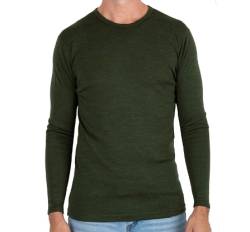
The most affordable base layer (midweight) from all merino wool brands. Keeps you warm without cutting down on quality/feel too much.
➥ SMARTWOOL uses denser, less itchy wool than Meriwool. Lineups that fully utilize this are:
–
- Leggings: This women’s base-layer pair has been the choice for women around me. The men’s leggings are great too.
– - Base layers: Smartwool 250 crews (check example) in particular are the best in their weight category.
– - Casual socks: The Everyday Margarita are unisex, have great designs, and are the most comfortable socks I’ve laid a foot in.
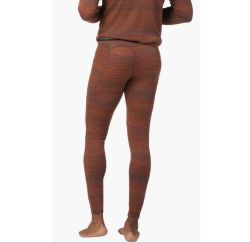
Very comfy, very warm, and coming in several fascinating designs no other brand offers. Great value for the price.
I’ll be honest with you. For some smaller pieces of clothing like scarves, me and my SO actually knit our own!
We’ve tried a lot of merino yarn. None of it would match either Meriwool or Smartwool when it comes to actual layers, though. It also takes a lot of time:
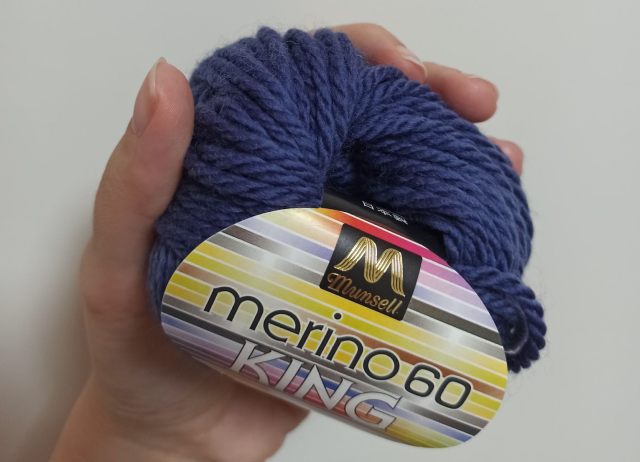
➥ MINUS33 comes last, but not least on our list.
Price-wise, the brand stands right between Meriwool and Smartwool. Several products I feel deserve recommendations are:
–
- Casual T-shirts: the Algonquin short sleeve crew is affordable, perfect for spring to autumn activities, and fits better than competitors.
– - Hiking socks: the Day Hikers are breathable, comfy, and come with full cushioning for mountain trail action.
– - Ultra warm layers for harsh weather: the Yukon Expedition crew is an industry leader. As far as leggings for freezing temperatures go, the Katmai leggings are unbeatable.
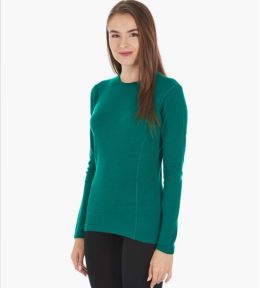
Exciting colors on a crew top that's extra heat-retaining. Perfect for both leisure time or more adrenaline-infused sports activities.
Now that I got the recommendations out of my system, let’s continue with some more insights on the merino wool lineups from these three brands.
It’s obvious that all three brands are moisture-wicking, eco-friendly, and very comfy. We’ll be taking a look at some finer print differences between them.
Meriwool vs Smartwool:
A review on which performs best and when
I mentioned how Meriwool isn’t your typical new generation merino wool brand. What does that actually mean?
Well, a lot of these newcomers utilize cheap production. Many don’t source proper materials (read: merino from New Zealand or Australia). Or, they feature a reduced percentage of merino wool (<60%) in the fabric materials.
While Meriwool undercuts its competitors in terms of price, it doesn’t sacrifice merino fundamentals. A few examples would be:
- Meriwool clothes don’t pill faster during washes (a lot of newer brands do that).
- The clothing uses properly sourced merino wool which accounts for 80-100% of the total fabric.
So what’s the tradeoff, then? Why compared to Smartwool, Meriwool is sometimes almost double the cheaper?
Smartwool uses denser merino wool in its clothing. Meriwool relies on different thread materials, which makes its clothing not as warm and slightly itchier.
You can see Meriwool long sleeves using fine or superfine wool:
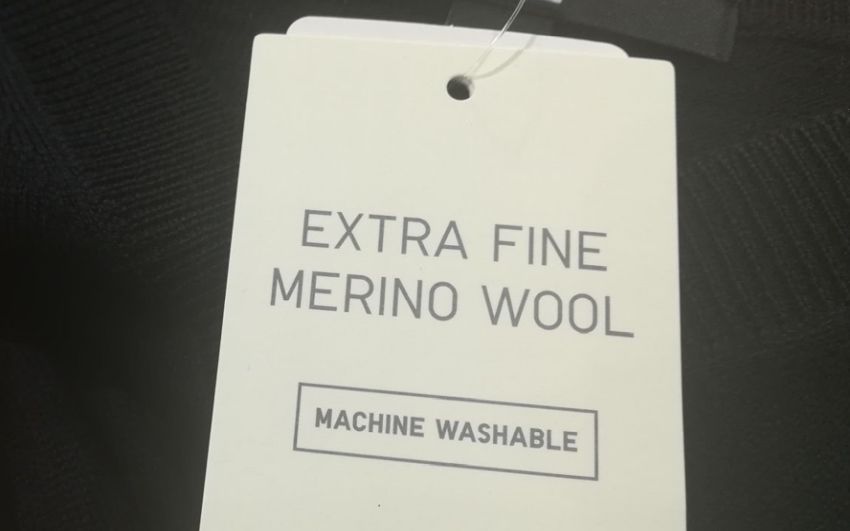
To some people, those initial few weeks of merino wool becoming less itchy are a big deal. And it’s no secret that Smartwool products are especially consumer-friendly in this regard.
The denser merino wool Smartwool uses also means you’ll be better equipped in the colder months.
As a rule of thumb, Meriwool is great for early spring to late autumn. If you live somewhere with milder winters, their merino wool clothes would fare well too.
As far as harsher winters go, though, Smartwool’s base layers (check some unconventional colors), midweight crews or leggings will perform better in colder areas.
| Product | Image | ||
|---|---|---|---|
|
Best base layer all-around
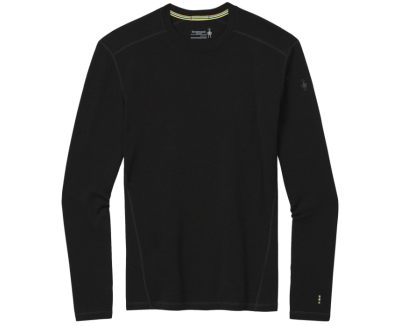
|
Smartwool Baselayer Crew
|
Check Sizes & Fit |
Last but not least, Smartwool products feature improved stitching. Their seams are also better designed and thus slightly more convenient/durable.
The finer merino wool in Meriwool products has one big benefit, though: it dries quicker and is generally more breathable.
If you’re looking for some cycling or hiking in a milder climate, you’d appreciate their approach to merino wool manufacture.

The most affordable base layer (midweight) from all merino wool brands. Keeps you warm without cutting down on quality.
Meriwool vs Minus33:
A heavyweight enters the picture
In the beginning, I pointed out how price-wise, Minus33 generally positions itself between Meriwool and Smartwool.
In some segments, this has a clear reason. One such example is the brand’s midweight base layer – the Chocorua crew.
While more premium than Meriwool and just a notch below Smartwool, it features a reduced density. The other two brands have their crews at 250g/m2, while the Minus33 is 235g/m2.
This might look like a small detail, but it still cuts down on manufacturing costs and helps the brand snuggle itself between its competitors.
The equivalent to the Chocorua for women is the Ossipee midweight crew:
| Product | Image | ||
|---|---|---|---|
|
Women's pick for colder seasons
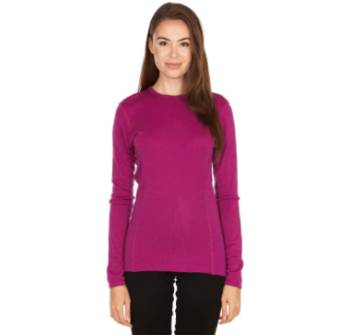
|
Minus33 Ossipee Midweight Crew
|
Check Price on Amazon |
The reason I mentioned heavyweight is Minus33 products’ forte, though.
The brand’s name points out a very concrete specialization: expedition-grade gear. If you noticed, my recommendations for their products were all centered around hiking or general extreme weather outdoor activities.
Minus33 might take grams per square meter off their base layers, but they put them all back when it comes to heavyweight layering. As an example, usually, you see merino wool outer shells or jackets going at 380g/m2.
Both the Katmai leggings and the trademark classic, the Yukon Crew feature a 400g/m2 interlock knit construction. The design and density make them a superior choice if you’re set on conquering icy landscapes or freezing conditions.
Furthermore, there’s one additional benefit to how Minus33 approaches their merino wool clothing.
The size fitting is generally snugglier and more ‘as expected’ than most industry brands, Smartwool and Meriwool included.
Some merino wool basics:
Layering, grams per square meter, and microns
If you look at the product lineup of all three brands, you’d notice terms like microns, g/m2, layering, etc.
The way merino wool works is slightly different than your typical clothes. Its moisture-wicking qualities, as well as the retention of heat makes merino a very versatile material for layering and ‘composing’ a harsh weather-proof strategy.
Generally, there are three main types of layers:
- Base layer
- Midweight (mid) layer
- Outer shell (heavy) layer
Some think of the midweight layer as an ‘insulating’ layer too.
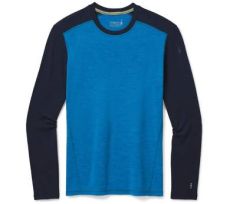
Lightweight and warm, with supreme stitching that keeps it fray-free for longer. 100% premium merino wool.
These main types of layers correspond to specific densities – that would be the grams per square meter. Generally, the gist of it is:
- Base layers range from 150 g/m2 all the way to 200g/m2.
- Midweight layers range from 230-260g/m2. Most mid-merino wool crews you’ll see are 250g/m2.
- Outer shells or merino wool jackets range between 360-400g/m2.
Meriwool themselves have a very neat short video on layering if you’ll be packing for an extended trip somewhere up the snowy peaks.
As far as Smartwool goes, I have a guide on their 150 and 250 layers.
When it comes to other budget brands, I’ve also discussed Merino.Tech here. Interestingly enough, they start their base layers at 165g/m2, instead of the traditional 150g/m2.
Going beyond layer classifications:
An additional detail is the so-called micron as a measuring unit. The micron is basically a measure of whether the merino wool piece of clothing is soft or pricklier.
At its core, merino wool is simply a combination of many fibers put together. When the fibers range between 15 and 19 microns, they are considered anywhere from fine to super fine. This makes them slightly softer on your skin.
In comparison, when the merino goes above 30 microns, it’ll feel coarser. You might notice it prickling on your skin and it’ll definitely feel a bit itchier.
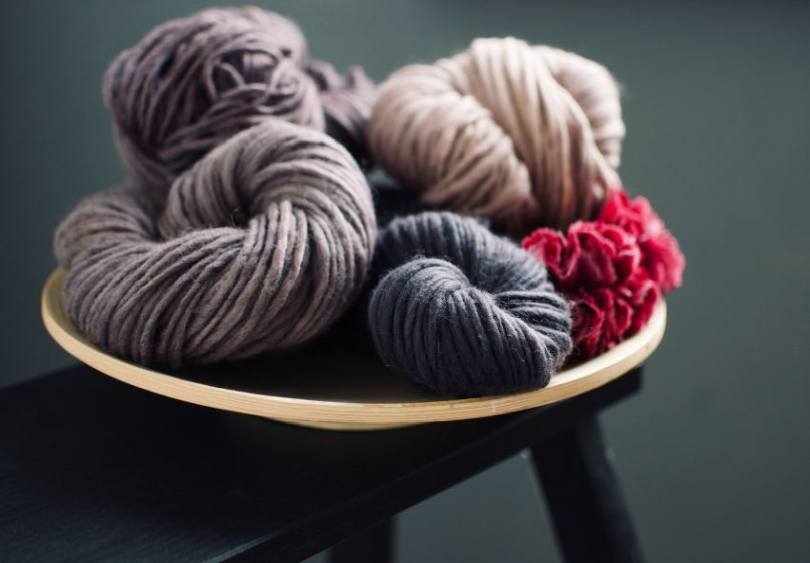
Conclusion
As I said, I tend to be a bit verbose when it comes to things I’m hyped about. Hopefully, that wasn’t too long of a read and you could gain some knowledge on the difference between Meriwool, Smartwool, and Minus33.
I’m definitely of the mindset that you don’t have to always overpay for merino wool clothing.
In light of this, I reiterate that in my opinion, Meriwool is a total bargain for things like cheaper (but quality!) merino wool accessories.
When it comes to higher-end requirements, though, I believe both Smartwool and Minus33 warrant their higher price tag.
There’s a fun fact, by the way. I haven’t spoken of another competitor, Icebreaker. A few years ago, Smartwool and Icebreaker were a fierce competition with each other under different companies.
Now they’re both owned by the same enterprise – VF Corporation after it acquired Icebreaker in 2018. They own quite a bit of outdoor brands (The North Face, Napapijiri, Timberland). At the same time, they spun off their workwear division into a corporation called Kontoor. I’ve written about them in my Wrangler vs Rustler jeans article, as Kontoor owns both brands.
What a rollercoaster of apparel events, huh?
In any case, thanks for reading! Let me know about your experiences with any of the three merino wool brands. What did you enjoy about them – or alternatively, what were you disappointed with?
- Woolx vs Smartwool: Discussing Some Details - October 4, 2023
- Best Struts For Honda Accord & Element: What Works - September 22, 2023
- Bilstein vs Monroe Shocks: My Opinion On What Works Best - September 19, 2023


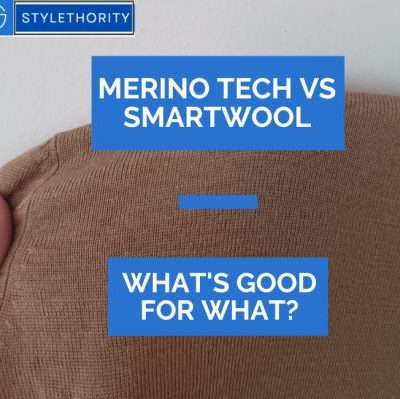
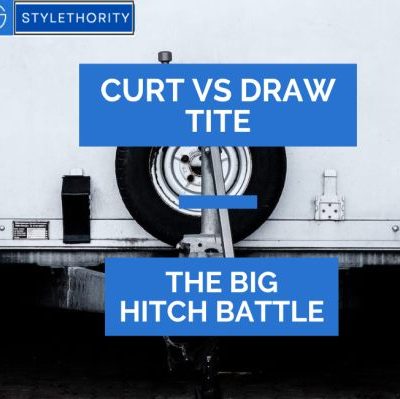
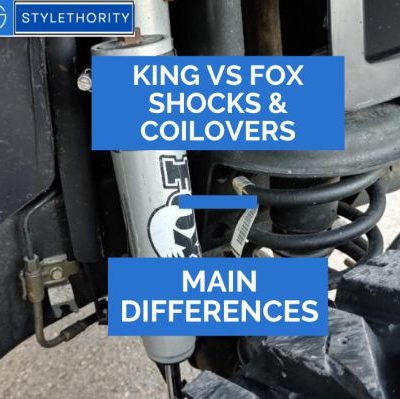

What do u think about what Lil quality cc filson has and how much they raised prices tho most are not In USA any longer material went down in quality thickness and living on a previous 100 year reputation now they are proving the reputation meant nothing in quality or in quality control
Hey Jason!
Honestly, I haven’t had any experience with Filson so I can’t comment on that. However, a lot of otherwise reputable brands (clothing) I’ve used have declined over the past decade or so. Thankfully, none of the three brands I mentioned here have a STEEP decline in quality compared to what they offered before!
I own many smartwool socks. Love them. However, my base, mid, and outer layers are all minus33.
I tossed out an icebreaker shirt 5 years ago because it smelled horrible with just a little sweat.
I hike, hunt, lounge and travel with my merino wool. I spent a week — 10/31/22-11/04/22 — in Bergamo, Italy and I was glad I brought my midweight minus33 shirt. Had to wear it more than expected in the cold and rain. Amazing how my minus33 and smartwool has never had a hint of scent on it. Both smart wool and minus33 last if you don’t abuse the material. Stay clear from abrasive activities like picking up large rocks or logs. I have sewn a few holes. Use a thin “work-grade” layer to cover your awesome merino wool. I just bought a new bottom and top after 5 years of heavy use. My previous set is thinning in the knee/thigh area but the rest looks great.
Hey Matt!
First of all, thanks for sharing your experience. I appreciate you leaving a comment!
And yes, I feel Minus33 is REALLY underestimated as a brand. From what I’ve heard among friends in EU countries, for example, you can find Smartwool somewhat easily. Minus33 is a pain in the butt to find in quite a few countries that otherwise have a healthy selection of merino wool/outdoor products.
Also totally agreed on the abrasive materials. Especially with any 150 (or even 250) line you’re guaranteed to tear through them if you’re not careful.
Cheers!
Thank you for this. Wish I had found and read this site before my recent purchase –of which I will now return every bit after I repurchase based on what I’ve read herein.
My Application: Walking and bicycling a square block perimeter in temps 32-15\F for two to three hours, afterwards retreating to a vehicle with an internal temp of 45-50\F. <– this continues for twelve hours. Top layer is only a vest; dexterity is the second priorty to warmth.
My takeaway from this post is –the recommended and/or goto products are: the Yukon Expedition crew -and- the Katmai leggings. Based soley on 'your' experience, what Smartwool variate would you recommend?
Hi!
Now, I’m not sure how you react to outside temperatures (whether your body runs hot or cold, that is).
If the Katmai caught your eye, a decent Smartwool alternative should be the Intraknit Thermal Max: https://www.smartwool.com/shop/mens-base-layers/mens-intraknit-thermal-max-merino-base-layer-bottom-sw016824 These are a step above in terms of warmth than the usual 250g base layer leggings Smartwool has: https://www.amazon.com/Smartwool-Merino-Baselayer-Bottom-X-Large/dp/B083QD5MJQ/ The Thermal also has some reflective elements that MIGHT help a bit with cycling in duskier environment too.
Personally, I’d be fine with the 250 layer, but then again I live in a somewhat colder area so I’m used to temperatures like 15-20F.
I’ll be honest in that I don’t think Smartwool has an alternative to the Yukon Expedition. A lot of their fleeces or thicker sweaters feature a mix of merino wool and polyester which wouldn’t be as warm IMHO. The Yukon really is a champion in its category – both in terms of merino wool actual % in the fabrics, and in overall warmth.
Hope I could help at least a bit!
Xander
Xander, Thank you. My reaction to cold, I think, is normal\average. When I’m active, shoveling snow, I’ll generate enough heat that would cause sweating, while wearing a lined-winter coverall and cotton long-johns; from Walmart. However, I’m no longer that active –with the exception of patrolling a square block or two as previously describe. I do tend to sit-down with ‘Mother Nature’ and read the paper in-between cycling and walking. In addition having the occasional encounter that has me standing at a scene for extended lengths.
All said and done, I’m initially going with Expedition and Katmai; this pay-check. Next two (02) to three weeks, I’ll see about acquiring the SmartWool suggested alternatives you offered. If you’re interested, I’ll get back to you –with my results to included date/time/temp. Again, a big thank you for this website.
Respectfully,
Query-01
Hey!
Sounds good, let me know your impressions, it would be helpful for future readers who go through the comments too!
I hope the initial batch of clothing pieces fit you well. I’d say that in general Minus33 stays closer to conventional label sizes compared to Smartwool. At least that’s what I’ve seen; their products on Amazon have a huge percentage of ‘true to the fit stated’ reviews too.
Best of luck and hope the purchase is worth it! And thanks for the kind words 🙂
Xander